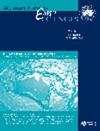中国西北东昆仑造山带早-中志留系Delite二长花岗岩和石英正长岩:岩石成因及其对原特提斯构造演化的启示
IF 0.9
4区 地球科学
Q3 GEOSCIENCES, MULTIDISCIPLINARY
引用次数: 0
摘要
摘要东昆仑造山带原特提斯构造演化存在争议。本文报道了Delite地区早古生代侵入岩的岩石学、全岩地球化学、锆石U–Pb地质年代学和锆石Lu–Hf同位素新资料。LA-ICP-MS锆石U–Pb同位素数据表明,Delite二长花岗岩和石英正长岩形成于437.0 ± 2.9 马和424.8 ± 2.2 马。Delite二长花岗岩含有高SiO2、Al2O3、K2O和A/CNK比率,但MgO和Mg#值较低(33–38)。本研究认为二长花岗岩是一种典型的S型花岗岩,起源于同碰撞环境中古代地壳碎屑物质(变质杂砂岩)的部分熔融。石英正长岩富钾、贫镁,Mg#值较低(36-41),显示出碰撞后玄武岩下地壳部分熔融产生的碱性正长岩的地球化学特征。结合之前的工作,我们建议在EKOB的中间部分,Proto-Tethys在大约437关闭 马在约427年后发生碰撞 Ma。关键点锆石LA-ICP-MS U–Pb同位素数据表明Delite二长花岗岩和石英正长岩形成于437.0 ± 2.9 马和424.8 ± 2.2 马。Delite二长花岗岩是在同碰撞环境中形成的。Delite石英正长岩与碰撞后环境有关。有人认为,原特提斯在约437年结束 Ma在EKOB的中间部分,碰撞后的设置在大约427年之后 马在心电图室。本文章由计算机程序翻译,如有差异,请以英文原文为准。
The early–middle Silurian Delite monzogranite and quartz syenite, East Kunlun Orogenic Belt, NW China: petrogenesis and implications for tectonic evolution of the Proto‑Tethys
Abstract The tectonic evolution of the Proto‑Tethys in the East Kunlun Orogenic Belt (EKOB) is controversial. Herein, new petrological, whole-rock geochemical, zircon U–Pb geochronological and zircon Lu–Hf isotopic data for early Paleozoic intrusive rocks in the Delite region are reported. LA-ICP-MS zircon U–Pb isotopic data show that the Delite monzogranite and quartz syenite were formed at 437.0 ± 2.9 Ma and 424.8 ± 2.2 Ma, respectively. The Delite monzogranite contains high SiO2, Al2O3 and K2O and A/CNK ratios, but low MgO and Mg# values (33–38). This study considers that the monzogranite is a typical S-type granite and originated from partial melting of ancient crustal clastic material (metagreywacke) in a syn-collision setting. The quartz syenite is K-rich and Mg-poor, with low Mg# values (36–41), exhibiting geochemical signatures of an alkalic syenite derived from partial melting of basaltic lower crust in a post-collision setting. Combining with the previous work, we suggest that in the middle part of the EKOB the Proto-Tethys closed at ca 437 Ma with a post-collisional setting after ca 427 Ma. KEY POINTS Zircons LA-ICP-MS U–Pb isotopic data indicate that the Delite monzogranite and quartz syenite were formed at 437.0 ± 2.9 Ma and 424.8 ± 2.2 Ma, respectively. The Delite monzogranite was formed in a syn-collision setting. The Delite quartz syenite was related to the post-collision setting. It is suggested that the Proto-Tethys closed at ca 437 Ma in the middle part of the EKOB, and the post-collisional setting was after ca 427 Ma in the EKOB.
求助全文
通过发布文献求助,成功后即可免费获取论文全文。
去求助
来源期刊

Australian Journal of Earth Sciences
地学-地球科学综合
CiteScore
2.80
自引率
8.30%
发文量
45
审稿时长
6-12 weeks
期刊介绍:
Australian Journal of Earth Sciences publishes peer-reviewed research papers as well as significant review articles of general interest to geoscientists. The Journal covers the whole field of earth science including basin studies, regional geophysical studies and metallogeny. There is usually a thematic issue each year featuring a selection of papers on a particular area of earth science. Shorter papers are encouraged and are given priority in publication. Critical discussion of recently published papers is also encouraged.
 求助内容:
求助内容: 应助结果提醒方式:
应助结果提醒方式:


